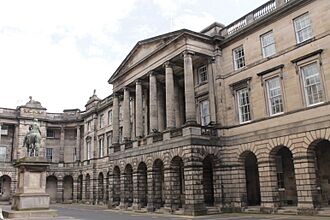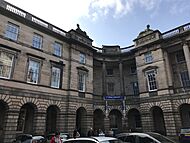Parliament House, Edinburgh facts for kids
Quick facts for kids Parliament House |
|
|---|---|
|
Taigh na Pàrlamaid
|
|

Parliament Square and Parliament House
|
|
| General information | |
| Type | Houses of the Supreme Courts of Scotland (1707–) Parliament of Scotland (1639–1707) |
| Architectural style | Renaissance (1632-1640) Classical (1803-1810; 1827-1838) |
| Address | 2-11 Parliament Square EH1 1RQ |
| Town or city | Edinburgh |
| Country | Scotland |
| Coordinates | 55°56′56″N 03°11′26″W / 55.94889°N 3.19056°W |
| Current tenants | Scottish Courts and Tribunals Service |
| Construction started | 1632 |
| Opened | 1639 |
| Technical details | |
| Material | ashlar and coursed rubble, timber and slate roofing |
| Floor count | Eight |
| Design and construction | |
| Architect | James Murray (1631-40) Robert Reid (1803-10 and 1827-38) William Burn (1827-29) |
|
Listed Building – Category A
|
|
| Official name: The Supreme Courts of Scotland excluding extensions onto Cowgate at southeast of site, 2-11 Parliament Square, Edinburgh | |
| Designated | 14 December 1970 |
| Reference no. | LB27699 |
Parliament House (Scottish Gaelic: Taigh na Pàrlamaid) is a group of buildings in the Old Town of Edinburgh, Scotland. It is home to the Supreme Courts of Scotland, which are the highest courts in the country. The oldest part of Parliament House was used by the Parliament of Scotland from 1639 to 1707. It was the world's first building made just for a parliament.
Parliament House is located near the Royal Mile and St Giles' Cathedral. It also serves as the main office for several legal groups, like the Faculty of Advocates. Other important buildings in the complex include the Advocates Library and the Signet Library. The entire group of buildings is a Category A Listed building, meaning it is a very important historic site.
Contents
The Story of Parliament House
Before Parliament House
In the 1600s, the Parliament of Scotland did not have its own special building. It often met in a place called the Tolbooth in Edinburgh. This building was also used by the city council and a court called the Court of Session.
Later, Parliament started meeting inside St Giles' Cathedral. But by the 1630s, more and more members were joining Parliament. The space in the cathedral became too small. People also wanted St Giles' to be used only as a church again. So, King Charles I asked the city council to build a bigger, better place for Parliament.
Building Scotland's Parliament
In March 1632, the city council decided to build a new parliament chamber. James Murray, the King's Master of Works, designed it. The building cost a lot of money, about £127,000 Scots. Most of this money came from Edinburgh's own funds, and the rest was given by the people of Edinburgh.
Parliament House was built between 1632 and 1640. It was put on land that used to be a burial ground next to St Giles' Cathedral. Some old houses were taken down to make space for the new building. Even though it wasn't fully finished until 1640, Parliament House hosted its first meeting on August 12, 1639.
The building had an L-shape. The main part had three floors. The top two floors held the Parliament Hall and the Laigh Hall. Below these was an underground area. There was also a two-story wing called the Treasury, which had rooms on each floor.
The front of the building, facing Parliament Yard (now Parliament Square), was made of smooth stone. The rest was made of rougher stone. The main entrance had a fancy top part with the Royal Arms of Scotland. There were also statues of Justice and Mercy, and a Latin saying: Stant His Felicia Regna ("Kingdoms stand happy by these virtues"). These statues were later moved inside Parliament House.
Parliament Hall

Parliament Hall is a very large room, about 40 meters long and 12 meters wide. It was used as the main meeting place for the Parliament of Scotland. When Parliament was not meeting, the Court of Session used the hall.
A special part of Parliament Hall is its beautiful oak roof. It was built in 1637 by John Scott. In the 1600s and 1700s, the walls were decorated with tapestries and pictures of Scottish kings and queens. The large stained glass window, added in 1868, remembers the start of the College of Justice in 1532.
King Charles I was the first king to attend Parliament in the hall in 1641. Later, King James VII and Queen Anne also visited. Parliament Hall was also where important discussions happened about the Treaty of Union between Scotland and England in 1706-07. This treaty joined the two countries.
After the Union in 1707
The Courts of Scotland

After the Acts of Union 1707, the Parliament of Scotland was closed down. So, Parliament House was no longer used for its main purpose. Instead, it became the main home for Scotland's courts, including the Court of Session and the High Court of Justiciary. The national records of Scotland were kept in the Laigh Hall until 1789, when they moved to a new building.
Until the mid-1800s, Parliament Hall was also used as a public hall for events in Edinburgh. It hosted music concerts, including famous works like Handel's Messiah. A big dinner was also held there when George IV visited Edinburgh in 1822.
Changes and New Courtrooms
In the early 1800s, Parliament House went through many changes. New courtrooms were built for different parts of the legal system. By 1844, the Lords Ordinary (judges) moved out of Parliament Hall into their own new courtrooms. Over the years, more parts of the building were added or changed to fit the growing needs of the courts.
Parliament House Today
Today, Parliament House is mainly the home of the Court of Session. This is Scotland's highest court for civil law cases (cases about people's rights and money). Most of the work of the High Court of Justiciary, Scotland's highest criminal court, happens in a different building nearby. Parliament Hall itself is now used as a meeting place for lawyers.
Features of the Building
Architecture and Libraries
Robert Reid designed the outside of Parliament House between 1803 and 1838. He gave the whole complex a grand, unified Classical look on the north side. This style was influenced by other famous architects. The front of the building has three stories and a large entrance with columns. It also has a fancy top edge with decorative panels.
The Advocates Library was started in 1682. It is in a building designed by William Henry Playfair in 1830. It is still a very important resource for lawyers. Besides legal books, it also used to collect all kinds of books. In 1925, the non-legal books were given to the new National Library of Scotland, which is right next to it.
The Signet Library is located near the north end of Parliament Hall. It is a private library for members of the Society of Writers to Her Majesty's Signet, who are usually lawyers. Its construction began in 1810 and it also has a classical look.
Laigh Hall
Below Parliament Hall is the Laigh Hall. Its first use is not fully clear. It might have been used for smaller parliamentary meetings or for storage. From 1662, important legal and parliamentary records of Scotland were kept here. These national records stayed in the Laigh Hall until 1789. The famous Scottish guillotine was also stored in the Laigh Hall at one time.
The Treasury Wing
The two-story wing on the southeast side is called the Treasury. The ground floor had an entrance area. The Court of Session used two rooms on the ground floor. The upper floor had the Treasury Room (used by the Treasurer), the Council Chamber (used by the Privy Council), and the Exchequer Room (used by the Court of Exchequer). During parliamentary sessions, these rooms were used by different committees.
See also
 In Spanish: Casa del Parlamento (Edimburgo) para niños
In Spanish: Casa del Parlamento (Edimburgo) para niños



